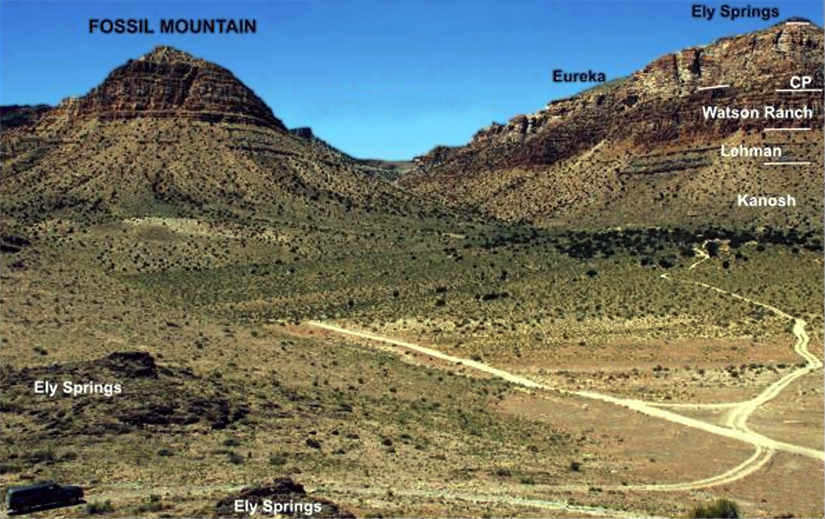
|
A view westward from an unnamed hill toward Fossil Mountain and the lower to late Ordovician rocks exposed immediately north. Symbols on photograph, from oldest to youngest exposures: "Kanosh" is the lower Ordovician Kanosh Shale (a member of the Pogonip Group); "Lehman"--lower Ordovician Lehman Limestone (youngest member of the Pogonip Group); "Watson Ranch"--middle Ordovician Watson Ranch Quartzite; "CP" is the middle Ordovician Crystal Peak Dolomite; "Eureka"--the middle Ordovician Eureka Quartzite (notice its increased thickness on the mountain immediately north of Fossil Mountain); and "Ely Springs" is the upper Ordovician Ely Springs Dolomite, known throughout eastern Nevada and western Utah for its abundant silificied corals and brachiopods, in particular. Note vehicle at lower left corner. Among the lettered geologic rock formations, the lower Ordovician Kanosh Shale and Lehman Limestone produce prolific assemblages of brachiopods, ostracods (bivalved crustacean), sponges, trilobites, gastropods, pelcypods, cephalopods, graptolites, conodonts, echinoderms, corals, and bryozoans, primarily, that often form shell beds composed of nothing but a single variety of fossil organism; for example, the Kanosh Shale is justifiably famous for its thick shell beds containing the prolific remains of a single species of brachiopod, called scientifically Shoshonorthis michaelis. Other beds produce abundant ostracods, gastropods, trilobites, or echinoderms, to the exclusion of all of other invertebrate animal types. Fossil Mountain in Millard County, Utah, could well yield the most diverse lower Ordovician fossil sequence in North America. I adapted and processed the photograph through photoshop from an image contained in the following publication: American Association of Petroleum Geologists Memoir 98, The Great American Carbonate Bank: The Geology and Economic Resources of the Cambrian-Ordovician Sauk Megasequence of Laurentia. Edited by James Derby, Richard Fritz, Susan Longacre, William Morgan, and Charles Sternbach. Published January 20, 2013. |